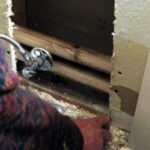As I stood in the middle of a house full of bare drywall, I realized in horror that over the next few days, I would be applying 20 gallons of primer and paint to these walls. My weapon of choice would be the new Wagner Paint ‘N Roll Plus. I sure hoped this gadget would work as it showed on the glitzy Paint ‘N Roll Plus box even though my gut was telling me it would be just another gizmo that wouldn’t live up to expectations.
The Paint ‘N Roll Plus is the latest evolution of the Wagner Paint Stick. There have been several versions throughout the years all based on the same idea. You suck paint into the handle of the tool and then gradually squeeze it out through the roller as you need it. In theory this makes the painting go faster and eliminates a lot of mess. The latest flavor of the paint stick from Wagner is the Paint ‘N Roll Plus. It has a couple of nice features, including a special tube and paint can cover that work together to easily allow you to suck paint into the tool and a double seal around the intake valve to prevent splattering when paint is being forced out. It also has a trigger on the handle so all you have to do to get more paint is just squeeze!
Assembling the product was fairly easy. Everything just snaps together in about five easy steps. There is one bit of advice buried in the instructions which I think is VERY important. I’m surprised it’s not highlighted in bright red letters. Make sure the seal of the plunger is coated generously with petroleum jelly. They include some in the package, but make sure you’re coating that seal every time you use the tool. The petroleum jelly is what keeps paint from leaking past the seal and it keeps the seal from wearing out.
One other note about assembly is that there’s a paint splatter shield included in the package. It goes over one side of the roller to prevent little drops of paint from flying off the roller and attacking your carpet and furniture. I chose not to use it because I was working in a complete construction zone. It didn’t matter if the unfinished sub-floor got a few little white speckles on it and I wanted to be able to switch the roller quickly from side to side to get near corners. You’ll have to decide when it’s appropriate to use that attachment, but I’ve read of people having trouble with the roller coming off while painting. I suspect it’s due to this attachment because I had no such trouble.
Day one of painting started with a couple five gallon buckets of primer. Like I said, it was a big job. Now the Paint ‘N Roll Plus comes with a nifty suction tube and cover to load paint from a one gallon can, but nothing for a five gallon. The idea behind the cover and tube is that you snap the suction tube into the cover and then snap the cover onto the can and that holds everything in place nice and tight. To refill the handle of the Paint ‘N Roll Plus you just slide the intake valve on the neck of the tool over the part of the tube that’s sticking out of the can and suck the paint into the handle. It works extremely well but it’s important that the tool is all the way down over the tube or it’ll suck in a little air.
With a five gallon bucket, the one gallon cover isn’t really useful. In hind sight, I would have been better off buying an empty one gallon paint can, transferring from the five gallon buckets to that and using the suction tube with the lid attachment. Instead I chose to stick the refill tube in by hand each time and then suck the primer directly from the five gallon buckets. When I was done with each fill I pulled the paint covered tube out and laid it in a paint tray for use later on. It was a little messy but it worked. If you’re working with five gallon buckets of paint, I’d suggest transferring the material to a one gallon can and using the lid attachment. It’s a lot cleaner, faster and easier.
Now it’s time for the actual rolling of paint! I found that it’s important to change the way I thought about painting with a roller when using this tool. You don’t really “load” the roller like you do with a paint tray and traditional roller. Instead, you squeeze the trigger many times while rolling across your surface. This will get the paint out of the handle of the Paint ‘N Roll and onto the surface you’re painting and that’s you’re goal. Once the paint is on the wall, use the roller to spread it out evenly. Don’t try to coat the wall evenly right away. Be generous getting the paint onto the roller and onto the wall so you can spread it around later. If you’re seeing the little dots from the paint seeping through the holes in the roller, you’re being too stingy.
One big question for me is whether this tool is really that much faster than a regular roller. The answer is a resounding yes. It’s also faster than the more expensive Power Roller options available because you can reach the entire wall without a step stool. As a comparison I painted one wall with a regular roller and painted a second wall of the exact same size with the Paint ‘N Roll Plus. It took about one third the time to paint the wall with the Paint ‘N Roll Plus.
When it came time for clean up, I discovered that there are tricks to that as well. The first step is to remove the roller assembly and take that apart. It snaps apart with a good firm tug. The plastic parts that hold the roller on and deliver paint to it came clean after 15 seconds under the garden hose with my thumb adding a little pressure wash where needed. The curved neck with the holes in snaps off the body of the tool and the best way to clean it is to just hold the hose up to it and let the water wash through it for about a minute.
With the painting assemblies cleaned up it was on to the paint stick itself. The first step is to disassemble the intake valve and clean off the two little rubber seals. Get them very clean so they remain flexible and won’t leak. Next it’s onto the body of the tool. The trick here is to use the plunger to suck water up into the tool and blast it back out. Do that about a dozen times and then unscrew the plunger from the handle, and rinse both pieces off. Be sure to spray out the end where the roller attaches and you are done! Some people claim it takes a half hour to clean this tool but with these tricks I managed to do a very thorough job in just about five minutes.
Now with all of that said, there are some drawbacks to this tool. First, it holds paint in the handle so some people may consider it too heavy. It’s about the same weight as a regular roller and a quart of paint combined so judge for yourself if that’s too heavy for you. If it is, you can try filling it half full and it’ll weigh a little less. Another thing to be aware of is that sucking the paint into the handle can require a fair amount of strength. If you go slow it’s not so bad, but if you try to pull the plunger all the way back fairly quickly, it can be quite a strain. Aside from that, the trigger is fairly easy to operate, but after a few days my hands were still quite sore. For most reasonable size household painting jobs I suspect most people would never even notice the trigger.
Probably the biggest thing to be aware of is the size of the tool. When filled with paint, the plunger will extend from the stick and add up to something that is tough to maneuver in a hallway or closet. For hallways, just paint sideways and for closets and smaller spaces I’d suggest using a smaller tool. This isn’t the right tool for that job. That being said, this IS the right tool for painting virtually every room in your house and doing it quickly. It will easily let you reach from floor to ceiling in one continuous motion and that makes for walls that are free from any hint of overlap areas and other tell tale roller nap issues. For ceilings, the Paint ‘N Roll Plus allows you to use a small step stool rather than a ladder and just as with the walls you can cover a lot of ground in a hurry without any roller nap issues.
As with all tools, there are pros and cons, but for me the Wagner Paint ‘N Roll Plus is the best and most effective painting tool I’ve ever used and that includes power rollers. Obviously there are applications such as rough cedar siding where this is not the best tool, but for the average interior paint job, I think you’ll find that it can’t be beat!




